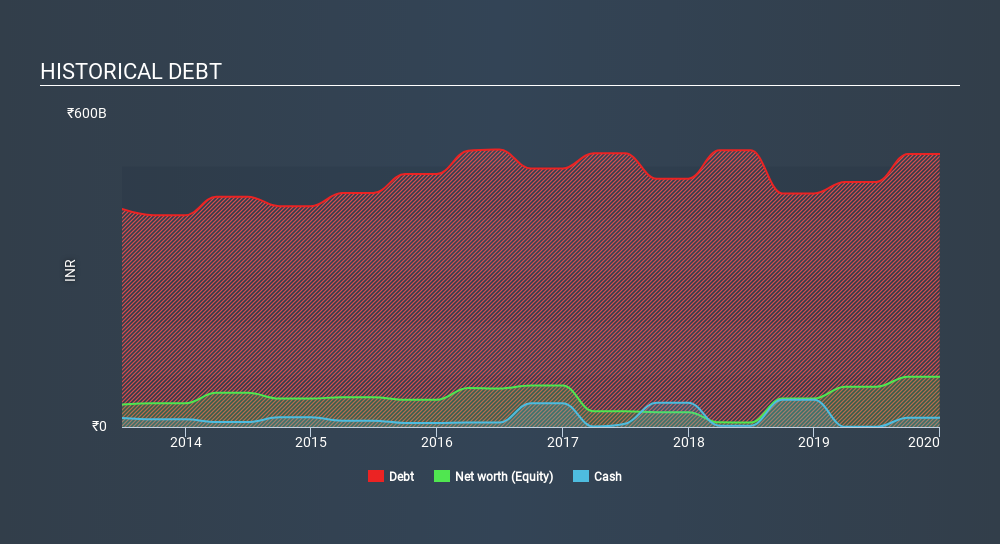- India
- /
- Renewable Energy
- /
- NSEI:ADANIPOWER
Does Adani Power (NSE:ADANIPOWER) Have A Healthy Balance Sheet?
Some say volatility, rather than debt, is the best way to think about risk as an investor, but Warren Buffett famously said that 'Volatility is far from synonymous with risk'. It's only natural to consider a company's balance sheet when you examine how risky it is, since debt is often involved when a business collapses. We note that Adani Power Limited (NSE:ADANIPOWER) does have debt on its balance sheet. But should shareholders be worried about its use of debt?
When Is Debt A Problem?
Debt is a tool to help businesses grow, but if a business is incapable of paying off its lenders, then it exists at their mercy. If things get really bad, the lenders can take control of the business. However, a more frequent (but still costly) occurrence is where a company must issue shares at bargain-basement prices, permanently diluting shareholders, just to shore up its balance sheet. Of course, plenty of companies use debt to fund growth, without any negative consequences. The first step when considering a company's debt levels is to consider its cash and debt together.
Check out our latest analysis for Adani Power
What Is Adani Power's Debt?
You can click the graphic below for the historical numbers, but it shows that as of September 2019 Adani Power had ₹523.5b of debt, an increase on ₹447.8b, over one year. On the flip side, it has ₹17.9b in cash leading to net debt of about ₹505.6b.

How Strong Is Adani Power's Balance Sheet?
The latest balance sheet data shows that Adani Power had liabilities of ₹194.3b due within a year, and liabilities of ₹465.1b falling due after that. Offsetting this, it had ₹17.9b in cash and ₹104.4b in receivables that were due within 12 months. So it has liabilities totalling ₹537.1b more than its cash and near-term receivables, combined.
This deficit casts a shadow over the ₹117.3b company, like a colossus towering over mere mortals. So we definitely think shareholders need to watch this one closely. After all, Adani Power would likely require a major re-capitalisation if it had to pay its creditors today.
In order to size up a company's debt relative to its earnings, we calculate its net debt divided by its earnings before interest, tax, depreciation, and amortization (EBITDA) and its earnings before interest and tax (EBIT) divided by its interest expense (its interest cover). This way, we consider both the absolute quantum of the debt, as well as the interest rates paid on it.
Adani Power shareholders face the double whammy of a high net debt to EBITDA ratio (7.5), and fairly weak interest coverage, since EBIT is just 1.2 times the interest expense. The debt burden here is substantial. On the other hand, Adani Power grew its EBIT by 20% in the last year. If it can maintain that kind of improvement, its debt load will begin to melt away like glaciers in a warming world. When analysing debt levels, the balance sheet is the obvious place to start. But it is future earnings, more than anything, that will determine Adani Power's ability to maintain a healthy balance sheet going forward. So if you want to see what the professionals think, you might find this free report on analyst profit forecasts to be interesting.
But our final consideration is also important, because a company cannot pay debt with paper profits; it needs cold hard cash. So we always check how much of that EBIT is translated into free cash flow. Happily for any shareholders, Adani Power actually produced more free cash flow than EBIT over the last three years. That sort of strong cash generation warms our hearts like a puppy in a bumblebee suit.
Our View
On the face of it, Adani Power's interest cover left us tentative about the stock, and its level of total liabilities was no more enticing than the one empty restaurant on the busiest night of the year. But on the bright side, its conversion of EBIT to free cash flow is a good sign, and makes us more optimistic. Looking at the balance sheet and taking into account all these factors, we do believe that debt is making Adani Power stock a bit risky. That's not necessarily a bad thing, but we'd generally feel more comfortable with less leverage. There's no doubt that we learn most about debt from the balance sheet. However, not all investment risk resides within the balance sheet - far from it. Consider risks, for instance. Every company has them, and we've spotted 2 warning signs for Adani Power you should know about.
Of course, if you're the type of investor who prefers buying stocks without the burden of debt, then don't hesitate to discover our exclusive list of net cash growth stocks, today.
If you spot an error that warrants correction, please contact the editor at editorial-team@simplywallst.com. This article by Simply Wall St is general in nature. It does not constitute a recommendation to buy or sell any stock, and does not take account of your objectives, or your financial situation. Simply Wall St has no position in the stocks mentioned.
We aim to bring you long-term focused research analysis driven by fundamental data. Note that our analysis may not factor in the latest price-sensitive company announcements or qualitative material. Thank you for reading.
About NSEI:ADANIPOWER
Adani Power
Engages in the generation, transmission, and sale of electricity under long term power purchase agreements (PPAs), supplemental PPAs, medium and short term PPAs, and on merchant basis in India.
Good value with adequate balance sheet.
Similar Companies
Market Insights
Community Narratives



